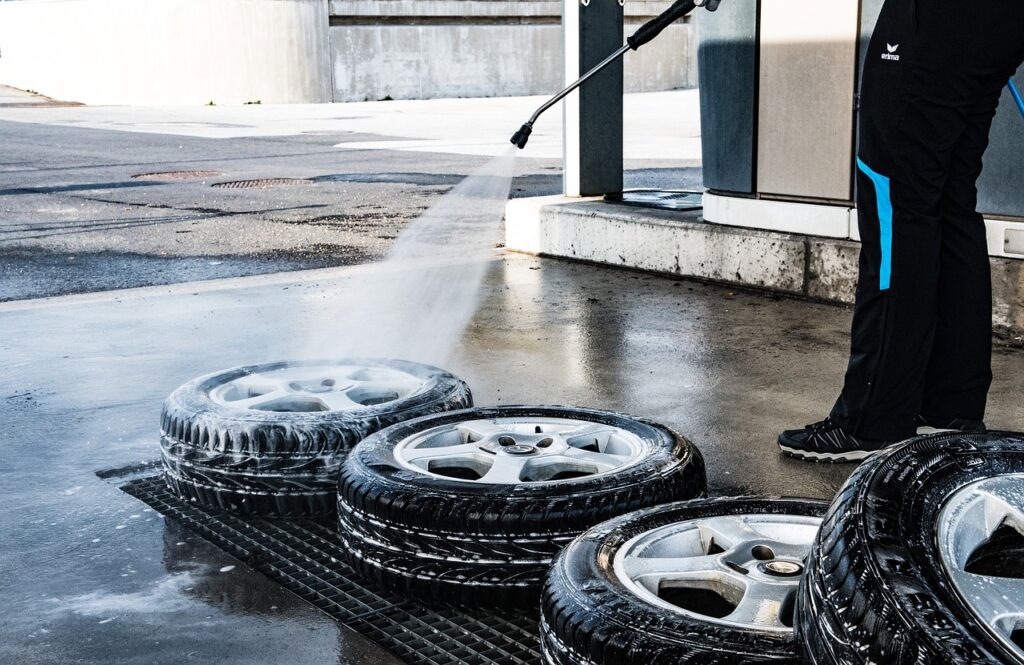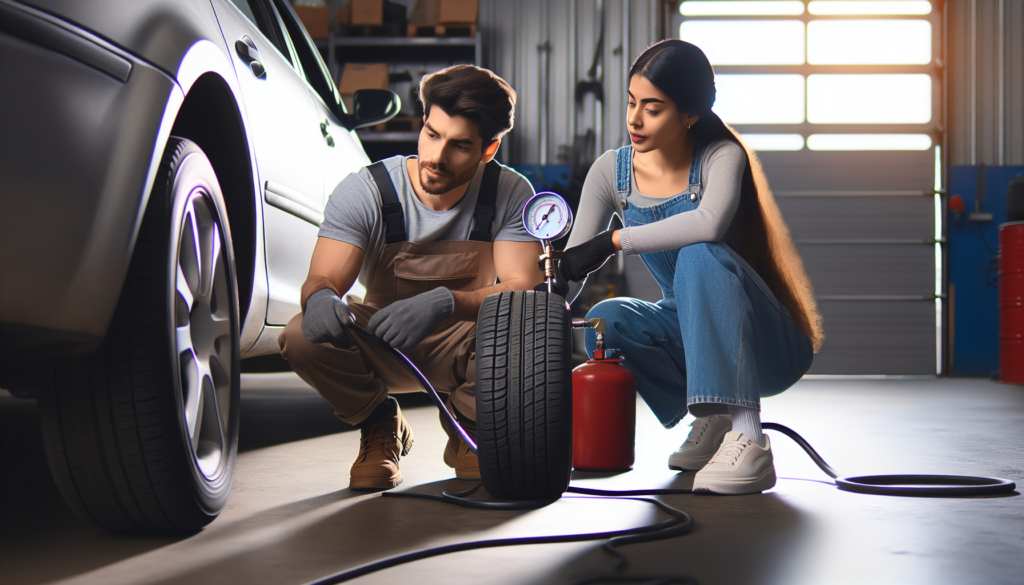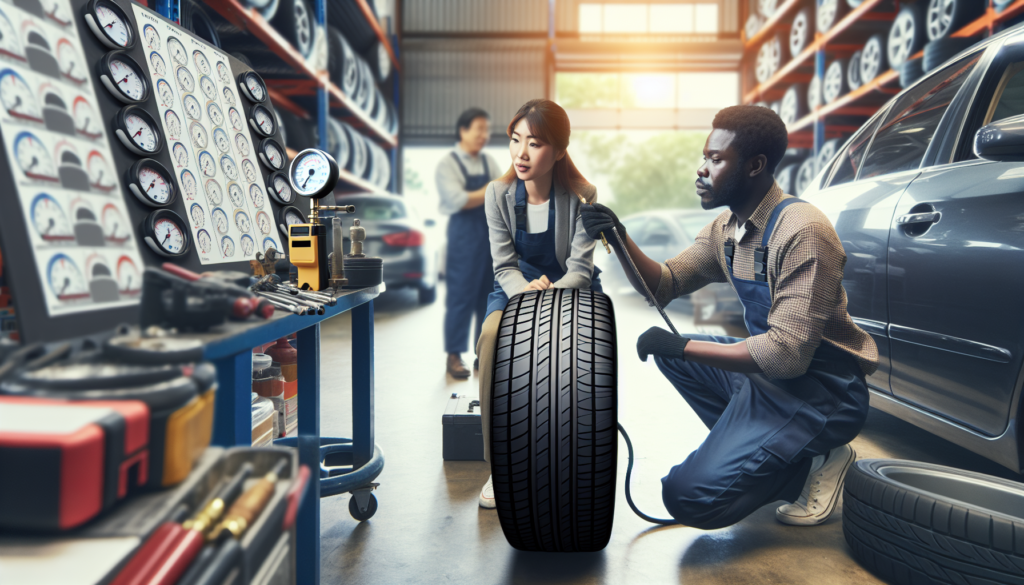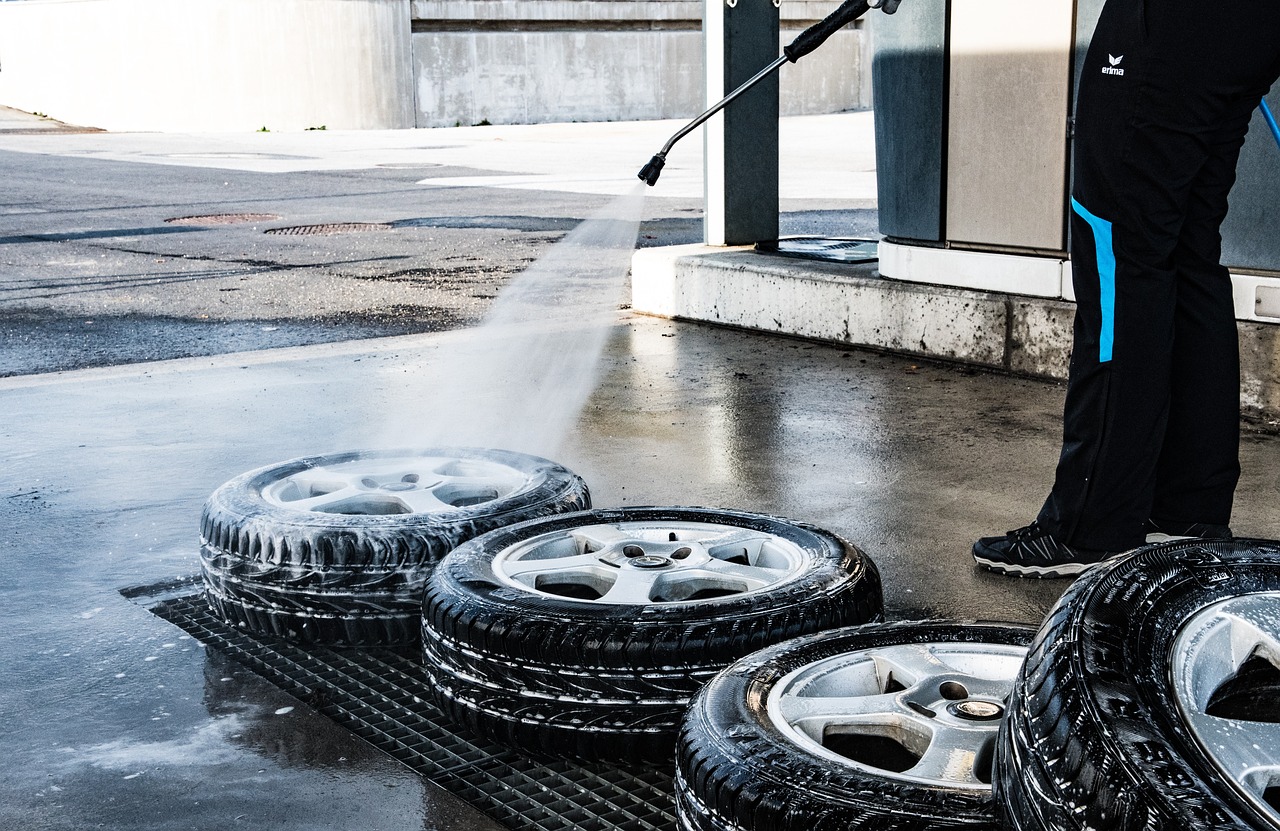Are you constantly wondering how to maintain consistent tire pressure in all your tires? It’s definitely a question that has crossed the minds of many car owners. Uneven tire pressure not only affects the performance and fuel efficiency of your vehicle but can also pose safety risks. So, in this article, we will explore some simple yet effective ways for you to ensure uniform tire pressure across all tires, giving you peace of mind on the road.
Assessing Tire Pressure
Understanding the Importance of Uniform Tire Pressure
Uniform tire pressure is crucial for the overall performance, safety, and longevity of your vehicle’s tires. When all tires have the same pressure, it ensures that they wear evenly, providing consistent handling and traction. Uneven tire pressure can lead to a range of issues, including decreased fuel efficiency, diminished handling capabilities, and increased risk of tire blowouts. Maintaining uniform tire pressure is essential for a smooth and comfortable ride, as well as for optimal vehicle performance.
Checking Tire Pressure Regularly
Regularly checking your tire pressure is an important part of tire maintenance. By doing so, you can identify any deviations from the recommended pressure levels and take appropriate action. It is recommended to check your tire pressure at least once a month, as well as before long trips or when there are significant changes in temperature.
Utilizing a Tire Pressure Gauge
To accurately assess your tire pressure, it is crucial to use a reliable tire pressure gauge. There are various types of tire pressure gauges available, including digital and analog ones. Digital tire pressure gauges provide precise readings, while analog gauges are generally more affordable. Whichever gauge you choose, make sure it is properly calibrated and easy to use. By regularly utilizing a tire pressure gauge, you can easily determine if your tires require inflation or if there is excess pressure that needs to be released.
Factors Influencing Tire Pressure
Several factors can influence tire pressure, including temperature changes, load distribution, and the type of tire used. As temperature increases, so does tire pressure, while colder temperatures cause a decrease in pressure. Load distribution is also a significant factor, as having uneven weight distribution in your vehicle can lead to varying tire pressures. Additionally, different types of tires have specific pressure requirements that must be considered to ensure optimal performance. Being aware of these factors will help you maintain uniform tire pressure and protect your tires from unnecessary strain.
Inflating Tires Properly
Determining the Correct Tire Pressure
To inflate your tires properly, it is crucial to know the correct tire pressure recommended by the vehicle manufacturer. This information can often be found in the vehicle owner’s manual or on a sticker located on the driver’s side door jamb or inside the fuel filler flap. The recommended tire pressure is typically listed in PSI (pounds per square inch) or kPa (kilopascals). Make sure to inflate your tires to the recommended pressure to ensure optimal performance, fuel efficiency, and safety.
Inflation Methods: Manual vs. Automatic
There are two primary methods for inflating tires: manual inflation and automatic inflation systems. Manual inflation involves using a tire inflator tool, such as a portable air compressor, to add air to the tires. It requires periodic monitoring of the pressure levels and careful adjustment to achieve the desired pressure. On the other hand, automatic inflation systems, also known as tire inflator systems, continuously monitor and adjust the tire pressure as needed. These systems provide convenience and ensure consistent tire pressure levels without the need for manual intervention.
Safety Precautions
When inflating your tires, it is crucial to follow specific safety precautions. Firstly, ensure that your vehicle is parked on a level surface with the parking brake engaged to prevent any accidental movement. Additionally, make sure to remove the valve cap from the tire before attaching the air hose. While inflating the tire, stand clear of the tire and do not overinflate it. Overinflating can lead to tire damage and increased risk of blowouts. It is essential to inflate the tire gradually, checking the pressure at regular intervals to avoid overinflation.
Avoiding Overinflation and Underinflation
Both overinflation and underinflation can have adverse effects on tire performance and safety. Overinflated tires have reduced contact with the road, leading to uneven tread wear and decreased traction. They are also more susceptible to damage from road hazards. Underinflated tires, on the other hand, flex excessively and generate heat, resulting in increased rolling resistance and reduced fuel efficiency. They are prone to premature tire wear and are more likely to suffer from blowouts. Maintaining the correct tire pressure is crucial to avoid these issues and ensure the longevity and safety of your tires.

Balancing Tire Pressure
Understanding Tire Load Distribution
Tire load distribution refers to the distribution of weight across the tires of a vehicle. Uneven weight distribution can lead to imbalanced tire pressure, causing uneven wear and compromised handling. To maintain uniform tire pressure, it is essential to ensure that the weight is evenly distributed among the tires. This can be achieved by properly loading your vehicle, distributing heavy items evenly and avoiding overloading one side of the vehicle. By maintaining a balanced weight distribution, you can promote uniform tire pressure and enhance the overall performance of your vehicle.
Rotating Tires to Promote Uniform Pressure
Regularly rotating your tires is another effective way to promote uniform tire pressure. Tires wear differently depending on their position on the vehicle. By rotating the tires regularly, you can distribute the wear more evenly, ensuring consistent tire pressure across all tires. The recommended tire rotation pattern may vary based on the type of vehicle and tire. It is advisable to consult the vehicle owner’s manual or seek guidance from a professional mechanic to determine the appropriate tire rotation pattern for your specific vehicle.
Using a Tire Balancer
A tire balancer is a specialized tool used to measure and adjust tire balance. It ensures that the weight is evenly distributed around the circumference of the tire, preventing any vibrations or uneven wear. Balancing the tires promotes uniform pressure and enhances the overall ride comfort. If you notice any vibrations or uneven tire wear, it is advisable to have your tires professionally balanced using a tire balancer. A professional tire balancing service can help identify any imbalance and take corrective measures to achieve optimal balance and uniform tire pressure.
Adjusting Pressure Based on Tire Position
Depending on the position of the tire on the vehicle, the recommended tire pressure may vary. It is essential to adjust the tire pressure based on the tire’s position to ensure uniform pressure across all tires. For example, front tires often bear more weight due to the engine, resulting in higher recommended pressure compared to the rear tires. By adjusting the tire pressure based on the tire’s position, you can optimize the performance, handling, and longevity of your tires.
Professional Assistance
Seeking Help from Experienced Mechanics
When it comes to maintaining uniform tire pressure and ensuring overall tire health, seeking assistance from experienced mechanics can be invaluable. Professional mechanics have the expertise and knowledge to accurately assess tire pressure and diagnose any underlying issues. They can provide accurate recommendations for tire pressure and assist in addressing any concerns or problems related to tire pressure and maintenance. Engaging the services of a qualified mechanic can provide peace of mind and help you maintain your tires in optimal condition.
Visiting Certified Service Centers
Certified service centers are equipped with the necessary resources and expertise to handle tire-related issues comprehensively. These centers employ trained technicians who specialize in tire services and are familiar with the specific requirements of various vehicles. By visiting a certified service center, you can have your tires professionally inspected, calibrated, and serviced as needed. They can also provide guidance on proper maintenance techniques and offer tailored solutions to ensure uniform tire pressure across all tires.
Professional Tire Pressure Monitoring Systems
Tire pressure monitoring systems (TPMS) are designed to continuously monitor and alert you about any deviations from the recommended tire pressure. TPMS can provide real-time information about tire pressure, helping you maintain uniform pressure across all tires. Professional TPMS not only monitor tire pressure but also offer additional features, such as tire temperature monitoring and tread depth measurement. Investing in a professional TPMS can provide enhanced safety, performance, and convenience when it comes to maintaining tire pressure.
Maintenance and Service Packages
Many mechanics and service centers offer maintenance and service packages that include regular tire inspections, pressure checks, and adjustments. These packages often provide comprehensive tire maintenance, ensuring that your tires are in optimal condition. By subscribing to such packages, you can have peace of mind knowing that your tires are being regularly monitored and maintained by professionals. These services typically include routine check-ups, tire rotations, balancing, and alignment, all of which contribute to maintaining uniform tire pressure and prolonging the life of your tires.

Addressing Common Issues
Tire Punctures and Leakages
Tire punctures and leakages can cause a drop in tire pressure, leading to an imbalance among the tires. It is essential to address such issues promptly to maintain uniform tire pressure. If you notice a sudden decrease in tire pressure or suspect a puncture, inspect your tires visually for any visible objects or damage. In the case of a puncture, it is recommended to have the tire repaired by a professional as soon as possible. Repairing punctured tires can restore their integrity and maintain uniform tire pressure across all tires.
Replacing Faulty Valve Stems
Valve stems play a crucial role in maintaining tire pressure. Over time, these stems can become brittle, damaged, or develop leaks. Faulty valve stems can result in a gradual loss of tire pressure, causing an imbalance among the tires. If you notice any signs of leakage around the valve stems or experience a consistent drop in tire pressure, it is advisable to have the valve stems replaced. Professionals can inspect and replace the valve stems, ensuring proper sealing and maintaining uniform tire pressure.
Dealing with Temperature Fluctuations
Temperature fluctuations can significantly impact tire pressure. As the temperature changes, the air inside the tires expands or contracts, affecting the tire pressure. In colder temperatures, tire pressure tends to decrease, while in hotter temperatures, tire pressure tends to increase. It is crucial to regularly monitor and adjust the tire pressure to compensate for temperature fluctuations. By addressing temperature-induced changes in tire pressure, you can maintain uniform pressure across all tires and ensure optimal tire performance and safety.
Identifying and Fixing Wheel Alignment Problems
Wheel alignment issues can lead to uneven tire wear and, subsequently, imbalanced tire pressure. If your vehicle pulls to one side, experiences vibration, or shows signs of uneven tread wear, it may indicate wheel alignment problems. Incorrect wheel alignment can cause uneven distribution of weight on the tires, resulting in variations in tire pressure. Seeking professional assistance and having your vehicle’s wheel alignment checked and corrected can help address these issues, promote uniform tire pressure, and enhance vehicle performance and safety.
Tips for Maintaining Uniform Tire Pressure
Regularly Inspecting Tires for Damage
Regularly inspecting your tires for signs of damage, wear, or aging is crucial for maintaining uniform tire pressure. Look for any visible cuts, bulges, cracks, or punctures on the tire surface. Pay attention to the tread depth to ensure it meets the recommended levels. If you notice any abnormalities or concerns, it is advisable to have your tires inspected by a professional. Timely identification and repair of tire damage can prevent pressure deviations and promote uniform tire pressure across all tires.
Maintaining Consistent Driving Habits
Consistent driving habits contribute to maintaining uniform tire pressure. Avoid sudden accelerations, aggressive braking, and excessive cornering, as these actions can cause uneven wear and affect tire pressure. Smooth and steady driving promotes even tread wear and ensures that the tires are subjected to similar levels of stress. By maintaining consistent driving habits, you can help minimize variations in tire pressure and promote uniformity among all tires.
Avoiding Excessive Speed and Rough Driving
Excessive speed and rough driving can increase the risk of tire damage and affect tire pressure. Driving at high speeds generates excessive heat, which can lead to tire failure and uneven pressure. Additionally, rough driving over potholes, speed bumps, or uneven road surfaces can cause damage to the tires and affect their pressure. To maintain uniform tire pressure, it is advisable to adhere to speed limits, drive cautiously on rough surfaces, and avoid sudden impacts that can compromise tire integrity.
Keeping Tires Properly Inflated during Storage
If you plan to store your vehicle for an extended period, it is essential to keep the tires properly inflated to maintain uniform pressure. During storage, tires can lose pressure gradually due to factors such as temperature changes and permeation. Before storing the vehicle, inflate the tires to the recommended pressure levels to compensate for any potential loss. Regularly check the tire pressure during storage and adjust as necessary to ensure that the tires remain inflated uniformly.

Utilizing Tire Pressure Monitoring Systems (TPMS)
Understanding TPMS Functionality
Tire Pressure Monitoring Systems (TPMS) are electronic systems that monitor the air pressure inside the tires and provide real-time information on tire pressure. TPMS typically consists of sensors mounted inside the tires and a receiver module that communicates with the vehicle’s onboard computer. The system continuously monitors the tire pressure and alerts the driver if there is any deviation from the recommended levels. By utilizing TPMS, you can proactively monitor and maintain uniform tire pressure across all tires, enhancing safety and performance.
Types of TPMS: Direct and Indirect
There are two primary types of TPMS: direct and indirect. Direct TPMS uses pressure sensors mounted inside the tires to directly measure the tire pressure. These sensors provide accurate and real-time readings of the tire pressure. On the other hand, indirect TPMS utilizes the vehicle’s anti-lock braking system (ABS) to monitor tire pressure indirectly. It relies on comparing the rotational speed of the tires to detect changes in tire pressure. While direct TPMS is more precise, indirect TPMS offers a cost-effective alternative for vehicles without built-in pressure sensors.
Benefits and Drawbacks of TPMS
The benefits of utilizing TPMS are numerous. It provides real-time monitoring of tire pressure, allowing drivers to take prompt action if any deviations are detected. TPMS enhances safety by alerting drivers of underinflated tires, reducing the risk of accidents caused by tire failure. It also improves fuel efficiency by maintaining optimal tire pressure, reducing rolling resistance. However, TPMS does have a few drawbacks. The initial cost of installation and potential maintenance or repair expenses should be considered. Additionally, TPMS requires periodic calibration to ensure accurate readings.
Installation and Calibration
To utilize TPMS, the system needs to be installed and calibrated properly. The installation process typically involves mounting the pressure sensors inside the tires and installing the receiver module in the vehicle. It is essential to ensure that the sensors are securely mounted and properly connected to the receiver module. Calibration is necessary to synchronize the TPMS with the vehicle’s computer system and ensure accurate readings. Calibration procedures may vary depending on the specific TPMS model and vehicle manufacturer. Professional installation and calibration services are recommended to ensure accurate and reliable TPMS functionality.
Understanding Tire Pressure Fluctuations
Effects of Temperature Changes on Tire Pressure
Temperature changes have a significant impact on tire pressure. As the temperature increases, the air inside the tire expands, resulting in an increase in tire pressure. Conversely, when the temperature decreases, the air contracts, causing a decrease in tire pressure. It is crucial to regularly monitor and adjust the tire pressure to compensate for temperature-induced changes and maintain uniform pressure across all tires. Temperature fluctuations can occur due to daily variations, seasonal changes, or extreme climates, and it is essential to be aware of their effects on tire pressure.
Seasonal Adjustments
Seasonal changes often require adjustments to tire pressure to account for temperature variations. As temperatures drop in colder seasons, tire pressure tends to decrease. It is advisable to consult the vehicle owner’s manual or seek guidance from a professional to determine the recommended tire pressure for different seasons. Adjusting the tire pressure according to seasonal changes helps maintain uniform pressure and ensures optimal tire performance and safety throughout the year.
Considerations for Extreme Climates
Extreme climates, such as extremely hot or cold regions, can have a significant impact on tire pressure. In high-temperature environments, tire pressure tends to increase, posing a higher risk of overinflation. Similarly, extremely cold temperatures can cause tire pressure to drop, leading to underinflation. It is important to regularly assess and adjust the tire pressure to counter the effects of extreme climates. Consultation with professionals familiar with the specific requirements of extreme climates can provide valuable guidance on maintaining uniform tire pressure in such conditions.
Preventing Underinflation in Cold Weather
Cold weather can cause tire pressure to drop, resulting in underinflation. Underinflated tires are more prone to wear, reduced traction, and increased rolling resistance. To prevent underinflation in cold weather, it is advisable to check the tire pressure regularly and inflate the tires to the recommended levels. Additionally, consider using nitrogen instead of regular air for tire inflation. Nitrogen is less affected by temperature changes, resulting in more stable tire pressure. By taking preventive measures and maintaining proper tire pressure, you can prevent underinflation during cold weather and ensure uniform pressure across all tires.

Educating Yourself on Tire Maintenance
Reading the Vehicle Owner’s Manual
The vehicle owner’s manual is an invaluable resource for understanding proper tire maintenance. It provides specific information regarding the recommended tire pressure, tire rotation patterns, and other important tire-related instructions. Reading the owner’s manual allows you to familiarize yourself with the manufacturer’s recommendations and comply with their guidelines for maintaining uniform tire pressure. The manual may also include specific tire maintenance instructions based on the type and size of the tires installed on your vehicle.
Understanding Manufacturer Recommendations
Each tire manufacturer provides recommended guidelines for tire pressure, rotation, and maintenance. These recommendations are based on extensive testing and research specific to their tire models. Understanding the manufacturer’s recommendations is essential for maintaining uniform tire pressure. It is important to follow these guidelines, as they are designed to ensure optimal tire performance, safety, and longevity. By adhering to the manufacturer’s recommendations, you can maximize the lifespan of your tires and maintain consistent pressure across all tires.
Learning About Tire Types and Ratings
Having a good understanding of different tire types and ratings can help you make informed decisions regarding tire pressure and maintenance. Tire types, such as all-season, summer, or winter tires, have specific pressure requirements to ensure optimal performance in different conditions. Additionally, tire ratings, such as load index and speed rating, impact tire pressure recommendations and maintenance. Educating yourself about tire types and ratings helps you choose the appropriate tires for your vehicle and maintain uniform pressure according to the specific requirements of the tires.
Benefits of Proper Tire Maintenance
Proper tire maintenance, including maintaining uniform tire pressure, offers numerous benefits. Consistent tire pressure ensures even wear, prolonging the life of your tires and reducing the need for premature replacements. Uniform tire pressure promotes optimal handling, traction, and fuel efficiency, enhancing the overall performance of your vehicle. Additionally, proper tire maintenance contributes to improved road safety, as underinflated or overinflated tires can lead to accidents or tire failures. By prioritizing tire maintenance and maintaining uniform pressure, you can reap these benefits and enjoy a safe and enjoyable driving experience.
Importance of Even Tire Wear
Causes and Consequences of Uneven Tire Wear
Uneven tire wear can have detrimental effects on tire performance, vehicle handling, and overall safety. There are several causes of uneven tire wear, including misalignment, improper tire rotation, suspension problems, and underinflation. If left unaddressed, uneven tire wear can lead to compromised traction, increased braking distances, and reduced cornering ability. It can also result in the need for premature tire replacements, leading to additional expenses. Maintaining uniform tire pressure and implementing proper tire rotation and alignment practices are essential to prevent uneven tire wear.
Impact on Vehicle Performance and Safety
Uneven tire wear negatively impacts vehicle performance and safety in various ways. Tires with uneven wear patterns have reduced contact with the road surface, resulting in compromised handling and traction. This can affect braking performance, increasing the stopping distance and reducing overall safety. Uneven wear also leads to vibrations and noise, resulting in a less comfortable driving experience. By maintaining uniform tire pressure and promoting even wear, you can maximize vehicle performance, safety, and overall driving comfort.
Rotating and Aligning Tires to Ensure Even Wear
Regularly rotating and aligning your tires is crucial for ensuring even wear and maintaining uniform tire pressure. Tire rotation involves periodically exchanging the positions of the tires to distribute wear more evenly. The recommended tire rotation pattern may vary depending on the vehicle type, tire type, and drivetrain. It is essential to consult the vehicle owner’s manual or seek guidance from a professional to determine the appropriate tire rotation pattern for your vehicle. Wheel alignment, on the other hand, ensures that the tires are properly aligned with each other and with the vehicle’s suspension system. Proper alignment reduces stress on the tires and helps prevent uneven wear.
Seeking Professional Help for Alignment Issues
If you notice signs of uneven tire wear or suspect alignment issues, it is advisable to seek professional help. Qualified mechanics can assess your vehicle’s alignment and perform necessary adjustments as needed. They have access to specialized equipment that enables precise alignment, ensuring that the tires are properly aligned and wear uniformly. By addressing alignment issues promptly and seeking professional help, you can prevent uneven tire wear, maintain uniform tire pressure, and promote optimal vehicle performance and safety.
In conclusion, ensuring uniform tire pressure across all tires is vital for the overall performance, safety, and longevity of your vehicle. Regularly checking tire pressure, utilizing a tire pressure gauge, and understanding the factors that influence tire pressure are key aspects of tire maintenance. Properly inflating tires, maintaining tire load distribution, and balancing tire pressure through rotation and alignment play significant roles in achieving uniform pressure. Seeking professional assistance, addressing common issues, employing maintenance tips, and utilizing tire pressure monitoring systems are essential in maintaining uniform tire pressure and optimizing tire performance. Finally, educating yourself on tire maintenance, understanding manufacturer recommendations, and recognizing the importance of even tire wear further contribute to keeping tire pressure uniform and ensuring safe and efficient driving experiences.


